Pressure Canning Chicken
Home pressure canning chicken is a wonderful way to preserve healthy meat for quick use in easy recipes and build up your home food storage!
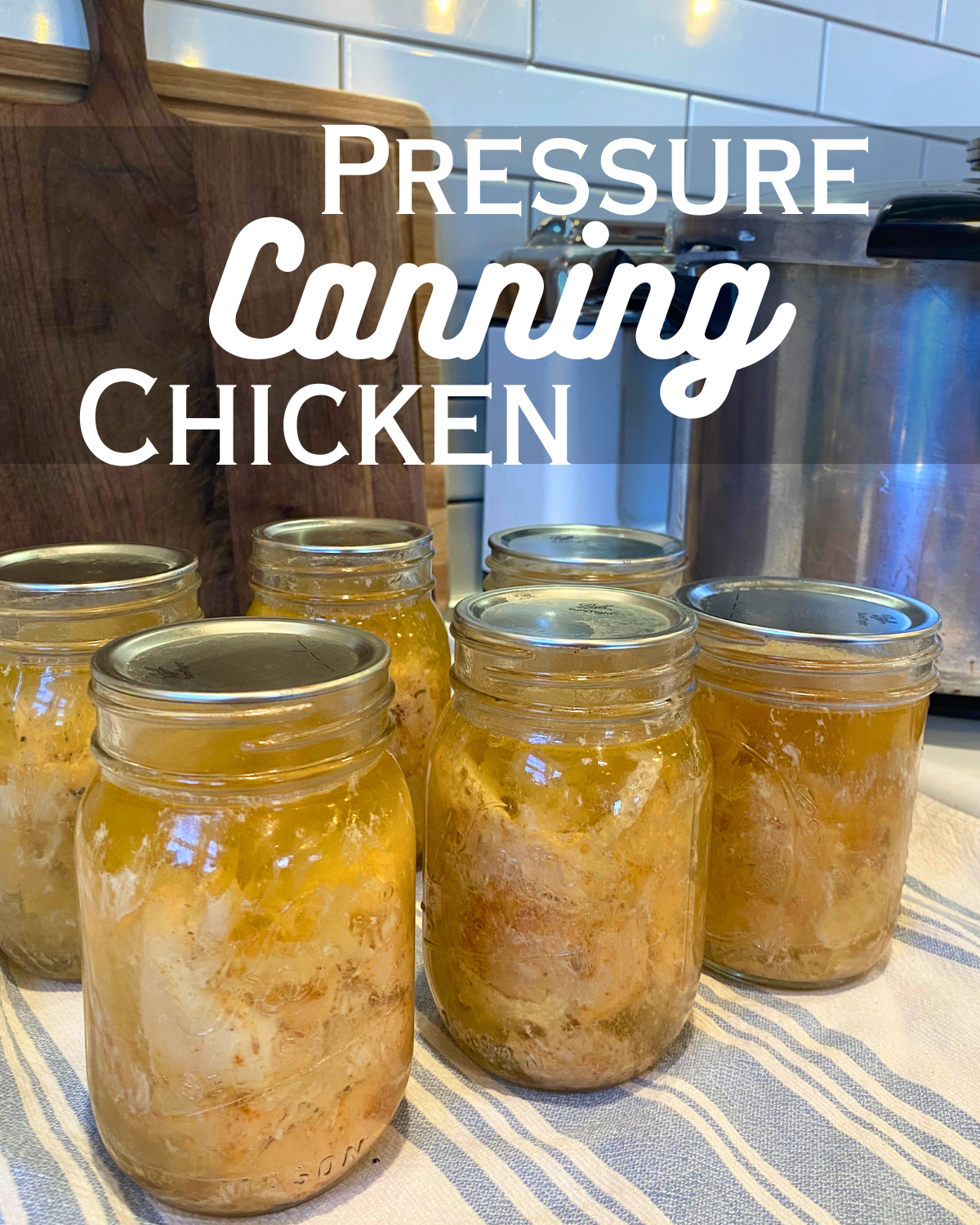
Jump to:
Easy Raw Pack Pressure Canned Chicken (Pints & Quarts!)
Fill your pantry with wholesome goodness that's quick to use and packed with flavor! This beginner-friendly guide takes you through the raw pack method for pressure canning chicken. It's easier than you think, and requires minimal effort compared to the hot pack method.
Why You'll Love This Recipe
- Effortless Convenience: Raw pack saves time and hassle compared to hot pack canning.
- Nutritious Staple: Enjoy home-canned chicken in soups, pot pies, salads, and more!
- Long-Lasting Shelf Life: Stock your pantry with shelf-stable protein for months to come.
Tools
- 6 (pint jars) or 3 (quart jars) clean canning jars. Use hot soapy water to clean your jars, no need to sterilize.
- New lids and bands
- Fresh chicken breasts or boneless chicken (boneless or remove meat from bones & trim fat)
- Optional: 1 teaspoon salt per jar
- 3 quarts water + 2 tablespoon vinegar (for 7-quart Presto canner)
- Pressure canner (not a water bath canner!) Chicken is a low-acid food making it unsafe for water bath canning.
- Butter knife or bubble remover.
- Jar lifter
- Chicken stock or cold water
- Canning funnel

Canning Process
- Prep: Wash jars and lids (no need to sterilize). Cut chicken into 1-inch cubes. Season with salt, if desired.
- Fill jars: Pack raw chicken pieces loosely, and add chicken stock or water leaving 1-inch headspace. Remove air bubbles with a butter knife. Wipe jar rims clean. Add clean lid and band, tighten finger-tight.
- Pressure Can: Fill canner with water and vinegar mixture. Place jars on rack, ensuring they don't touch. Secure lid and vent steam for 10 minutes.
- Pressure Build: Close vent and increase heat. Bring pressure to 10 pounds pressure (15 pounds at higher altitudes). When weights jiggle back and forth (or dial-gauge pressure canner reaches pressure), start timer.
- Process: Process pints pressure cooker for 75 minutes, quart jars for 90 minutes processing time.
- Cool Down: Turn off heat and let pressure release naturally. Wait 2 minutes after pressure dissipates before removing weights.
- Rest & Store: Wait 10 minutes, then carefully remove jars. Check seals, clean jars, and store on pantry shelf.

Tips
- Don't put cold jars in a hot canner. Heat them together to prevent breakage.
- Let pressure release naturally to avoid leaks.
- Home-canned chicken is a great way to prep for quick meals like chicken salad, chicken pot pie and chicken soup!
- You can can whole chicken using this recipe, just remove meat from bones and trim off excess fat from raw meat pieces.
Further Reading:
- The Ball Complete Book of Canning for more detailed instructions and troubleshooting.
Pressure Canning Chicken vs. Water Bath Canning
While home-canning chicken offers delicious and convenient benefits, safety is paramount. It's crucial to understand why using a pressure canner is mandatory for this task, and why a water bath canner is dangerously insufficient.
The Science of Safety:
Chicken, along with other low-acid foods, is susceptible to the growth of dangerous bacteria like Clostridium botulinum, which can cause botulism – a potentially fatal illness. Water bath canning reaches temperatures insufficient to eliminate these bacteria in low-acid foods.
Enter the Pressure Canner:
A pressure canner traps steam, raising the internal temperature significantly beyond what's possible with boiling water. This high heat reaches deep into the food, destroying harmful bacteria and ensuring safe storage for months.
Ignoring the Difference Can Be Deadly:
Using a water bath canner for chicken creates a false sense of security. The food may appear cooked, but deadly spores can remain viable, leading to severe illness or even death.
Pressure Canning Done Right:
- Follow a trusted recipe for raw pack or hot pack methods.
- Use a well-maintained pressure canner with reliable gauges and seals.
- Process chicken for the exact times specified for your altitude and jar size.
- Let pressure release naturally before opening the canner.
Investing in Safety:
A pressure canner may seem like an extra expense, but it's an investment in your family's well-being. Remember, there's no shortcut to safe food preservation.
Spread the Knowledge:
Share this information with others interested in home canning. By ensuring everyone understands the vital role of pressure canning for low-acid foods like chicken, we can prevent tragedies and promote safe practices within the community.
Enjoy the Rewards of Safe Canning:
With proper pressure canning techniques, you can enjoy all the benefits of home-canned chicken: convenient meals, budget-friendly options, and the satisfaction of preserving your own food. Just remember, safety always comes first!
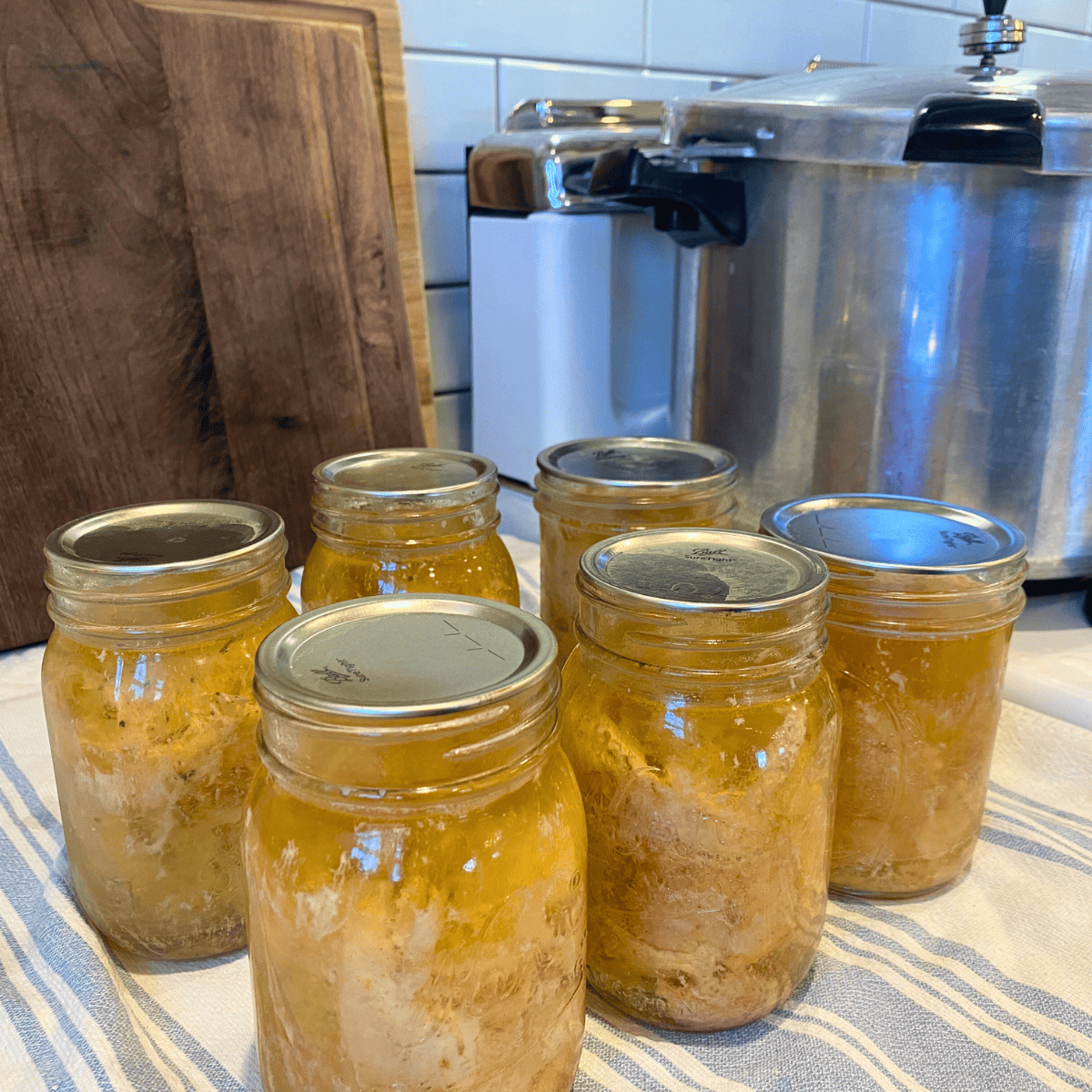
Hot Pack vs. Raw Pack
To Hot Pack or to. Raw Pack... That is the question! When it comes to chicken, both methods deliver delicious, shelf-stable results, but which reigns supreme for long-term storage? The Ball Complete Book of Canning, a revered authority in this domain, crowns Hot Pack as the long-term champion.
Hot Pack Pros:
- Enhanced Shelf Life: The precooking step in Hot Pack eliminates air, a potential enemy of long-term preservation. This reduces the risk of spoilage and extends the shelf life of your canned chicken, according to the Ball Complete Book, potentially beyond the typical one year for Raw Pack.
- Texture Consistency: Precooked chicken maintains its texture better during extended storage. Raw Pack chicken can soften slightly over time, which some may find undesirable.
- Flavor Infusion: Simmering chicken in seasoned broth infuses the meat with deliciousness. This pre-flavored base shines through after months of storage, offering a head start on creating flavorful meals.
Hot Pack Cons:
- Time Investment: Precooking adds an extra step, extending the overall canning process. If speed is your priority, Raw Pack might be your pick.
- Potential Toughness: Overcooking during precooking can lead to slightly tougher chicken texture. Finding the perfect simmer time is key.
- Limited Broth Options: Hot Pack often uses seasoned broth, restricting you to the pre-infused flavors during storage. Raw Pack allows for flexibility, letting you adjust broth flavors later.
Raw Pack Pros:
- Effortless Convenience: Skip the precooking step and pack raw chicken directly into jars. A time-saving boon for busy canners.
- Juicy Tenderness: Raw Pack chicken retains more of its natural juices, resulting in succulent, tender meat even after months.
- Broth Creativity: Unleash your culinary spirit! Raw Pack allows you to customize broth flavors later, adding versatility and creative control.
Raw Pack Cons:
- Limited Shelf Life: As mentioned, the Ball Complete Book suggests a slightly shorter shelf life for Raw Pack chicken compared to Hot Pack due to potential air pockets.
- Texture Change: Some report a slight textural softening in Raw Pack chicken over time, though still enjoyable for many.
- Flavor Neutral: Raw Pack chicken is a blank canvas, requiring additional seasoning when used, which some might find less convenient.
The Long-Term Storage Champion
The long-term storage crown goes to Hot Pack for its enhanced shelf life and texture consistency, thanks to the precooking step. However, Raw Pack offers undeniable convenience and flavor flexibility, making it a strong contender for those who prioritize speed and creative control. Ultimately, the best method is the one that aligns with your priorities and preferences.
Processing Time
Pressure canning your own chicken unlocks a pantry full of delicious goodness, but the magic truly happens during the "processing time." So, how long do you keep that pressure gauge jiggling for juicy wings and flavorful drumsticks? Don't fret, friend, this section guides you through the time warp like a seasoned canner.
How Long to Pressure Can That Chicken?
The Big Numbers:
First things first, processing time depends on two key factors: altitude and jar size. Don't worry, you don't need a scientific calculator. Here's a handy breakdown:
Altitude:
- Sea Level to 2,000 ft: This lucky zone gets 75 minutes for pint jars and 90 minutes for quarts, regardless of bone status (boneless or in!).
- 2,001 to 4,000 ft: Add a mere 5 minutes to each time in this intermediate zone. So, pints become 80 minutes and quarts a leisurely 95 minutes.
- 4,001 to 8,000 ft: Higher altitudes require more pressure power. Add 10 minutes for pints and 15 minutes for quarts in this range.
Jar Size:
- Pints: These smaller buddies get a slightly shorter processing time compared to their quart counterparts. Remember the pint times mentioned above!
- Quarts: Larger jars mean slightly longer pressure snoozes. Refer to the chart or add the relevant additional minutes based on your altitude.
Bone or No Bone?
Good news! Processing times are the same for boneless and bone-in chicken, both in hot pack and raw pack methods. The pressure penetrates deeply, ensuring safe and delicious results regardless of bone structure.
Remember:
- Always consult a trusted source like the Ball Complete Book of Canning for specific instructions and processing times for your recipe and altitude.
- Let the pressure release naturally. Don't rush it, or precious broth might seep out, affecting the seal.
- Enjoy the bounty! Your perfectly pressure-canned chicken awaits, ready to fuel quick meals, hearty soups, and endless culinary adventures.
So, ditch the guesswork and embrace the precision! With this processing time guide, you'll be mastering the art of pressure canning chicken in no time, filling your pantry with shelf-stable goodness and fueling your creative kitchen spirit.
Shelf Life
The shelf life of properly pressure-canned chicken is more nuanced than simply saying "up to a year." While the one-year timeframe is a general guideline, several factors can influence how long canned chicken remains safe and good to eat:
Factors Affecting Shelf Life:
- Processing method: Hot Pack tends to have a slightly longer shelf life due to precooking, while Raw Pack may last slightly less (around 8-10 months).
- Storage conditions: Cool, dark, and dry pantries are ideal. Avoid heat, light, and moisture.
- Jar integrity: A proper seal is crucial. Discard any jars with dents, bulges, or leaks.
- Quality of ingredients: Use fresh, high-quality chicken for optimal shelf life.
Nutritional Levels:
While it's true that nutrients like vitamins A and C may gradually decrease over time, especially in longer storage, canned chicken generally retains a good amount of its protein and other essential nutrients. However, it's not a complete dietary replacement for fresh or frozen chicken.
Beyond a Year:
While exceeding the one-year mark isn't recommended for guaranteed safety, some experienced canners report enjoying properly canned chicken even older than that. Remember, safety always comes first. If you're unsure about the age of your canned chicken or notice any signs of spoilage, discard it without hesitation.
Tips for Maximizing Shelf Life:
- Follow a trusted recipe with accurate processing times for your altitude and jar size.
- Use clean, sterilized jars and lids.
- Cool your pressure canner naturally before storing the jars.
- Monitor your pantry temperature and adjust storage if needed.
- Label your jars with processing date and contents.
Recipe Card
If you try this recipe and love it, I’d love if you give it 5 stars and let me know how it turned out in the comments or review! Tag me on Instagram @farmhouse_harvest with your delicious creation!

Pressure Canned Chicken Breast - Safely Canning Chicken
Home canning chicken is a wonderful way to preserve healthy meat for quick use in easy recipes and build up your home food storage!
Ingredients
- 6 large chicken breast
- *optional - 2 teaspoons taco seasoning
- *optional - 2 teaspoon "The Usual" seasoning
- About 2 cups Water
Instructions
- Check you canner and make sure the rubber ring and parts are all working right and not damaged.
- Clean your jars, and get new lids.
- Trim fat from chicken and cut into 1-2 inch cubes.
- *optional season half the chicken with taco seasoning and half with the usual seasoning, if desired.
- Fill jars evenly with chicken breast cubes.
- Top jars off to 1 inch head space with water
- Use a butter knife to remove air bubbles or pockets in the jar, and make sure there is 1 inch head space.
- Clean jar rims with a towel and vinegar
- Add a clean, new lid to the top.
- Add bands and tighten to finger tight.
- Put 3 quarts of water and 2 tablespoons vinegar into your pressure canner (for a 7qt presto canner). (Vinegar keeps your jars clean so they don't get an ugly film on them.)
- Load your jars in to canner, Secure the lid, and turn the heat up to medium - medium high.
- Let the steam vent through the vent hole for 10 minutes before placing weights on top. Recipe call s for a 10 pounds of pressure, but I am at a higher altitude so I use 15 pounds pressure or both weight rings.)
- Let the pressure canner come to pressure when the metal button pops up.
- When weights start rocking back and forth you can start your timer for 75 minutes (for pint jars) or 90 minutes for qt jars.
Nutrition Information
Yield 18 Serving Size 1Amount Per Serving Calories 67Total Fat 1gSaturated Fat 0gTrans Fat 0gUnsaturated Fat 1gCholesterol 34mgSodium 222mgCarbohydrates 0gFiber 0gSugar 0gProtein 12g
Let me know what you think!
Share your cooking tips and feedback in the comments below.
Did you add any twists to these recipes? I'd love to hear!
Canning Recipes
Applesauce Canning Recipe without Sugar
Crushed Tomato Sauce Canning Recipe
Tomatillo Salsa Canning Recipe
Cowboy Candy Jalapeno Canning Recipe

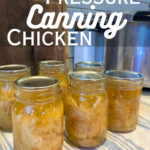
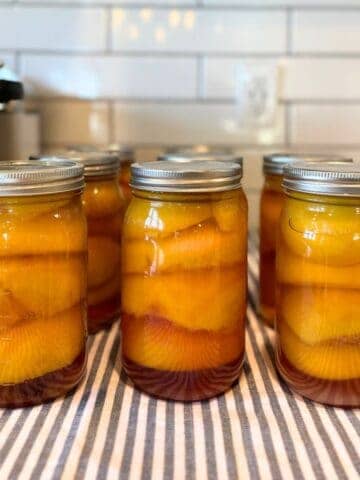
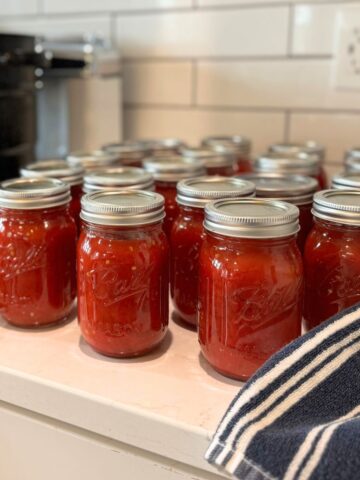
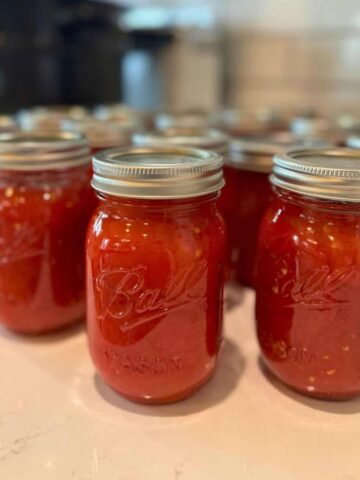
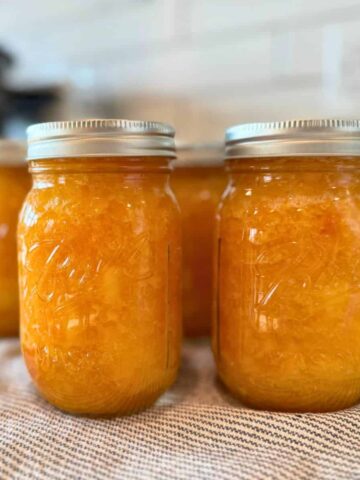
Did you make this recipe? Let me know!